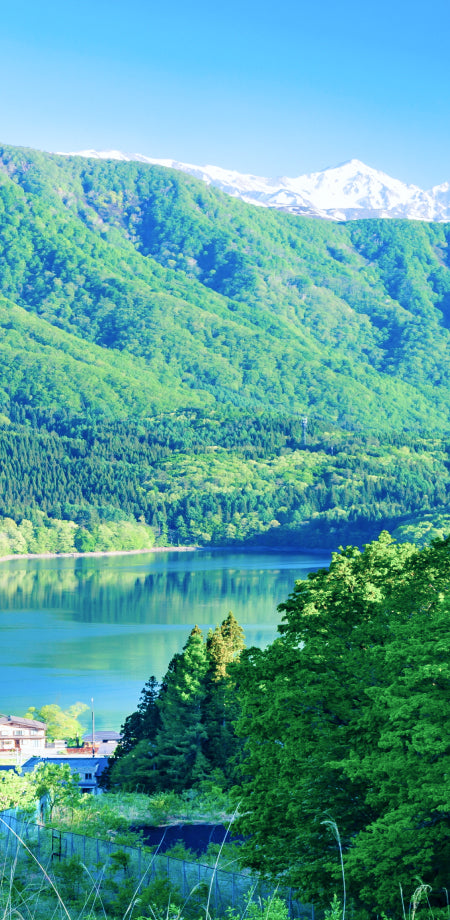投稿日:
更新日:
Let's dance!ShinshuThe breeze dance

Furyu Odori is a folk art piece that has been passed down in accordance with the local climate, hoping for good harvests, including the Bon dance, a popular tradition of Obon. In November 2022, 41 "Furyu Odori" nationwide were registered as UNESCO Intangible Cultural Heritage Sites. With the Obon season approaching, Nagano We will reaffirm the history and charm of the three "Furyu Dances" registered within the prefecture.
Vol.1 "Atobe's Dance Nembutsu" inherits the "Dance Nembutsu" founded by Ippen Shonin
Vol. 2 "Ninno Bon Odori" is a prototype of the Bon Odori, where three nights are spent offering memorializing gods and ancestors. Vol.3 "Nenbutsu Dance of the Harmony" with dynamic dynamics to pray for new Buddhist memorial services and good health
Vol.1 "Atobe's Dance Nembutsu" inherits the "Dance Nembutsu" founded by Ippen Shonin

Atobe Dance Nembutsu Preservation Society
Chairman Bono Noriko (center)
Advisor Kitamura Higashimi (left)
Advisor Hirooka Yutaka (right)
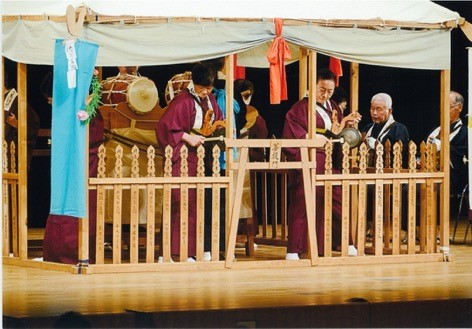
"Dance Nembutsu" is a place where you dance by pounding drums and bells, chanting Nembutsu and entering a state of ecstasy and selflessness, hoping for paradise to go to paradise. It is said that Ippen Shonin, the founder of the Toki sect, traveled around the country and spread it to the people during the Kamakura period, and is a folk entertainment that is said to be the root of Bon Odori.
It is said that this trend isSaku CityThis is the "Atobe Dance Nembutsu" that has been handed down by local residents in Atobe. It started in the winter of Koan 2 (1279). Ippen Shonin, who had been practicing Nembutsu worship throughout the country, returned to Zenkoji Temple on his way home from the Joku War and was swept away in Saku, and visited the grave of his uncle, who was caught up in the Joku War and lost to the land of Saku.Saku CityWe visited. At this time, the Nembutsu memorial service was held, and people's hearts began to swell and devotion began to spurt the Nembutsu, and it is said that the origins were when they began dancing while chanting Nembutsu.
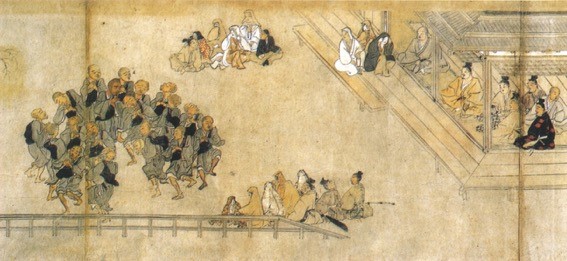
▲A dance and nembutsu at the "Bonokan" at Bannoso, Saku District, depicted in the Important Cultural Property "Paper Book of Ippen Shojin, Volume 2 (Kindaiji Hon)" (currently being deposited at Tokyo National Museum)
In an era when strict master-servant relationships existed under the feudal system, everyone, regardless of their lowly, danced and chanted Nembutsu, gained ecstasy, and the clear teachings that allowed them to reign in paradise, attracted the hearts of the oppressed common people. It also spread from the Saku region to the whole country. In the Saku region, the "Bono no City Garden" is a regular city (Saku CityIt is believed that this area became the center of the dance.

▲ "Atobe Elderly Rest House" near the monument to "Atobe's Dance, the birthplace of Nembutsu" has a corner introducing its history.
Even in the Edo period, when entertainment was strict, traditional dance and nembutsu were allowed, and it was held over five days during New Year and February in the lunar calendar. Records have been recorded that the "Atobe's Dance Nembutsu" was so busy that it was attended by 79 nearby villages.
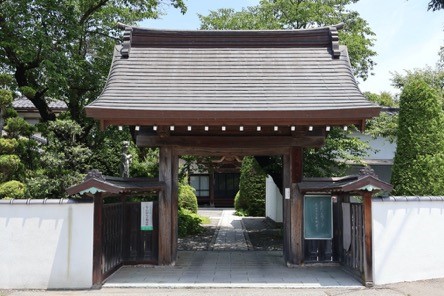
▲ "Saihoji" is a regular meeting held at the main hall every April.
The Atobe Odori Nembutsu Preservation Society is a place that conveys the precious prototype of this dance Nembutsu to this day. This preservation ceremony began with a community center activity calling for the revival of the dance Nembutsu that was suspended in World War II, and the revival performance was held in 1952, with the consensus of the residents of the district, Saihoji Temple. Chairman Banno Noriko says that the background to the revival was "in addition to the mission of cultural inheritance, and in the days after the end of the war, people were craving a place for people to enjoy and communicate with each other."
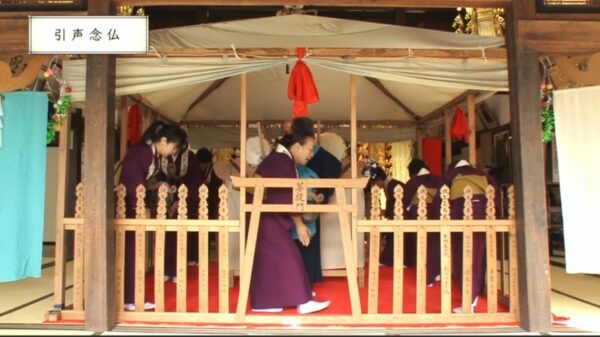
▲The dojo that will be assembled in the main hall has 49 shops and four torii gates around it, the roof is covered with white cloth, and a phoenix is held at the top to express the flight of the soul.
The revival performance was held in April before the busy season of farming, so a regular meeting is currently held at the main hall of the temple on the first Sunday of April every year. A dojo (stage) with two bays (3.38m) sides, which are considered to be Pure Land, was assembled in the main hall, and two drums were installed in the center. To the head of the two drumming sides, eight dancers chant "Namu Amida Butsu" and dance around the drums as they pound their bells.
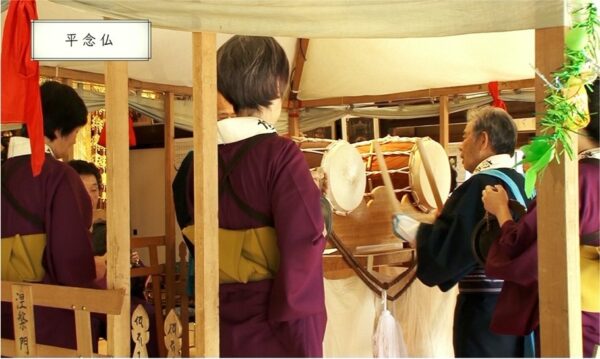
▲Eight dancers wear plain purple kimonos and white collars with the words "Namu Amida Butsu" written on them, dancing to the rhythm of the drums
The tempo gradually accelerated from the solemn chorus of the Nembutsu Japanese sung (wasan). The flow of dances that grows intense, and from leaning to joy, a sense of religious euphoria and ecstasy means purifying oneself, comforting their ancestors in the Pure Land, reborn and returning to this world, and salvation even to suffer others, bringing the origin of dance Nembutsu.

Finally, a wisdom dumpling will be distributed to share good fortune with the attendees. These tricolor dumplings are prepared by local people, and continue to support traditional culture in the area, conveying valuable Japanese traditional performing arts that were once considered one of the pleasures of the common people.
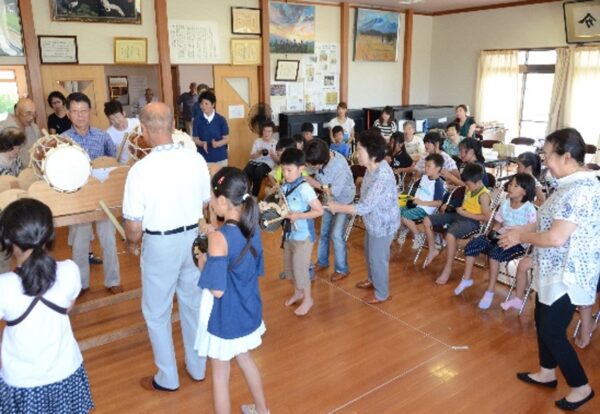
▲A scene of the children's dance Nembutsu practice held at regular meetings
On the other hand, in today's world, when times have changed and play has become more diverse, securing and nurturing successors is the challenge. Since 2007, the Preservation Society has been holding experiential learning activities to dance and convey the Nembutsu to elementary and junior high school students in the area. The fact that the company was registered as a UNESCO Intangible Cultural Heritage this time was a boost to succession activities, and "dancing people have said, "It has made it even more rewarding and it's easier for them to invite friends," says advisor Kitamura Higashimi.
The international recognition of the historical values founded by Ippen Shonin and the passion of the people who conveyed the culture has been a great encouragement for the local community in passing on to future generations.

Atobe Dance Nembutsu Preservation Society
address:Saku CityAtobe 424 (Saihoji Temple)
phone:0267-63-5321(Saku CityBoard of Education)
*This article is information as of July 2023.
Vol.2 "Ninno Bon Odori" is the prototype of the Bon Odori, where the gods and ancestors are offered throughout the three nights.

Niino Kogen Bon Odori Association
Chairman Hayashi Yatoshio
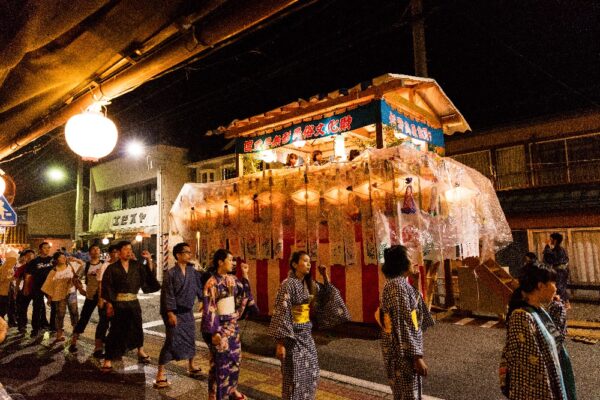
Minami, known as the "treasure of folk arts."Shinshu. Various festivals are transmitted to various places through the highways connecting Kanto and Kansai, and are alive and lively, changing depending on history and climate. Among them Nagano Anan Town, located at the southern tip of the prefecture, is so deep that it is known as the legend of the Heike clan's descent, and is a place where unique festivals that are rooted in simple life have been handed down. Two different style dances held during the Obon period have been registered as UNESCO Intangible Cultural Heritage Sites.
One of them is "Ninno Bon Odori." This quiet dance has been around for over 500 years in the Niino district, located on the southernmost prefectural border of the town. From 9pm to around 6am the next morning on August 14th to 16th, residents will be serving up the spirits in the shopping district, with six different dances being held every night, without a break. No instruments such as flutes or drums are used, and the only thing ondo is to say is "ondo" by five or six people on top of the yagura, and the "return" voices of the dancers around the yagura. The dance is a circle of dancers that dance in long, narrow circles about 500 meters east and west, with the center of the tower, and the movements are both simple and slow.

The ritual of "Dance God-send" held at the dawn of the last day is at its climax. After the old-fashioned procession "Noto", the Kiriko lantern brought to you from the Shinbon house is lit. It is said to be one of the prototypes of Bon Odori, a ritual that preserves the form of soul-sending and ancestral spirit faith before the introduction of Buddhism. Folklore scholar Yanagita Kunio was highly praised during the Taisho period, and is said to be one of the prototypes of Bon Odori.

▲The ritual of "Dance God-send." The lanterns are stacked in the square, and after a sailing ceremony by the Gyoja, the lanterns are lit with a signal of fireworks.
「民俗芸能の宝庫」といわれる南Shinshu. Various festivals are transmitted to various places through the highways connecting Kanto and Kansai, and are alive and lively, changing depending on history and climate. Among them Nagano Anan Town, located at the southern tip of the prefecture, is so deep that it is known as the legend of the Heike clan's descent, and is a place where unique festivals that are rooted in simple life have been handed down. Two different style dances held during the Obon period have been registered as UNESCO Intangible Cultural Heritage Sites.
One of them is "Ninno Bon Odori." This quiet dance has been around for over 500 years in the Niino district, located on the southernmost prefectural border of the town. From 9pm to around 6am the next morning on August 14th to 16th, residents will be serving up the spirits in the shopping district, with six different dances being held every night, without a break. No instruments such as flutes or drums are used, and the only thing ondo is to say is "ondo" by five or six people on top of the yagura, and the "return" voices of the dancers around the yagura. The dance is a circle of dancers that dance in long, narrow circles about 500 meters east and west, with the center of the tower, and the movements are both simple and slow.

This "Ninno Bon Odori" originated in 1529 during the Muromachi period. It is said that when Mizukoin was founded in the district, people from Furisoshimoda (Toei Town, Aichi Prefecture), which has a connection with it, visited this area to celebrate the opening of the mountain and danced it.
"Dances and songs have grown up listening to them as lullabies since childhood, and naturally blends in with the body."
This is what Hayashi Yatoshio, chairman of the Niino Kogen Bon Odori Association, who will be the president of the event. In recent years, due to the declining population of the district, there have been difficulties in maintaining operations and shortage of successors, so it is said that there have been some opposition among the association to register the UNESCO Intangible Cultural Heritage. However, it seems that he agreed with the hopes of excitement in the future.
"Even townspeople who have felt that Bon Odori, which has remained a traditional appearance, are reaffirming the charm of this, as they are actually special when they go out of town to go to college or get a job. Even if the circle of dances grows smaller, many people return home during the Bon Odori period and have a desire to inherit what they have been doing for generations, so I would like to continue looking for a way to continue."
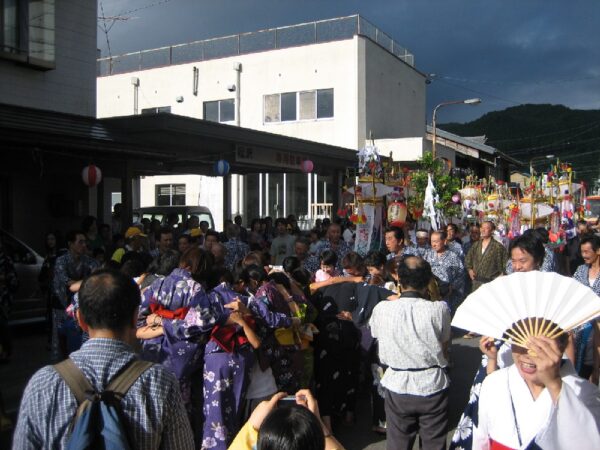
During the "Dance God-Subai", dancers who are hoping to stop the end of the Bon Odori dance continue to dance in circles of various sizes, in an attempt to stop the procession, reaching the climax of "Ninno Bon Odori".
Starting in 2004, children's classes have also been held for elementary and junior high school students. The Anan Town Board of Education is also planning to stream live for those who cannot return home in the future.
"The Niino Bon Odori is not something you can enjoy watching, and you can see how fun you can actually dance," says Hayashi. "The choreography is easy to remember and since ancient times, anyone can freely join the dance circle, so I hope many people will come here and participate."
The Niino Bon Odori is said to have been continued for the sake of memorial service and enjoyment of ancestors even under difficult circumstances such as World War II. After two years of hiatus due to the COVID-19 pandemic, it seems that people who want to continue protecting the situation are becoming stronger. Regional expectations are rising as the growing attention caused by UNESCO registration will lead to future maintenance and succession of operations.

Niino Kogen Bon Odori Club (Ninno, Anancho, Shimoina District)
address:Saku CityAtobe 424 (Saihoji Temple)
phone:0260-22-2270(Anan Town Board of Education)
https://mg.minami.nagano.jp/
*This article is information as of July 2023.
Vol.3 "Nenbutsu Dance of the Harmony" is a dynamic and dynamic prayer for new Buddhist memorial service and good health

Wagai Nembutsu Dance Preservation Society, MinamiShinshuFolklore Entertainment Inheritance Council
Chairman Hiramatsu Santake
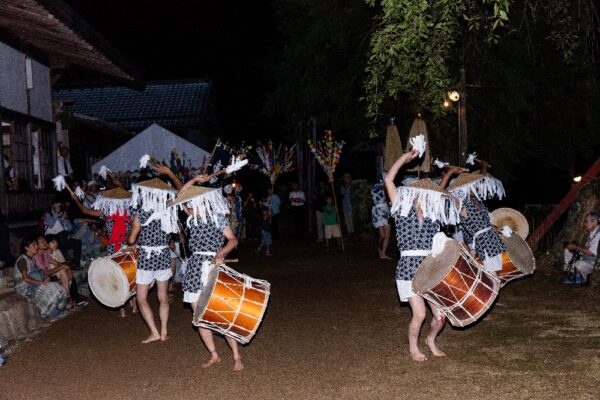
The Wagai Nembutsu Dance is held during the Obon period in Wagai district, located in the deepest mountain and haunted valleys of Anan Town. It is characterized by its dynamic dance, jumping up and down, and is said to have been the most enjoyable event of the year for local people who lived on steep slopes and were busy with farming.
There are various theories about its history, and according to one theory, in 1742, the 15th generation of the Miyashita family, who is said to be the founder of this area, went back to Edo to file a lawsuit, and on his way homeNagano City) and learned it as a souvenir from the village, and told the villagers. However, recent research has also believed that the dance was introduced from Enshu because the shapes of the Enshu Dai Nembutsu, which is passed down in Enshu, the birthplace of the Miyashita family, the founder family.

The dance will take place over four nights from August 13th to 16th. The setting is at three locations: Hayashi Shoji Temple on a high ground, Kumano Shrine, and Oya (Miyashita Family). On the first and last days, Nembutsu dances are held on all stages, with the hopes of offering ancestors, a bountiful harvest, and good health.
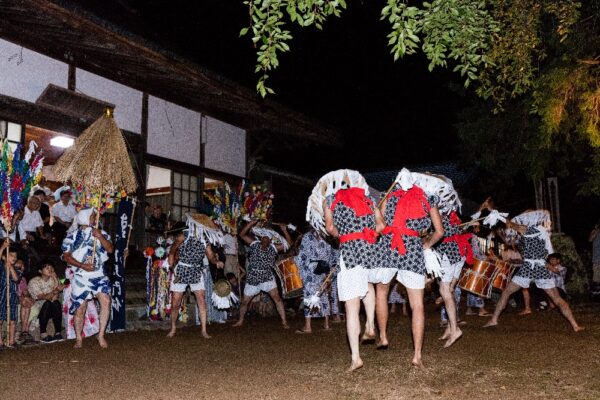
▲ Men wearing sedge hats with paper pads jump and dance violently. It is said to have summoned the spirits of the dead and expressed the joy that existed with the Buddha.
The dance consists of three parts: "in the garden", "nembutsu", and "wasan", and the centerpiece is "in the garden". The song begins slowly and solemnly and gradually becomes more intense, with six or seven people playing drums, barefoot hitchki (two dancers) leaping in and out, pounding each other's bodies as they slam their bodies together. The energetic 10-minute dance will overwhelm the viewer.
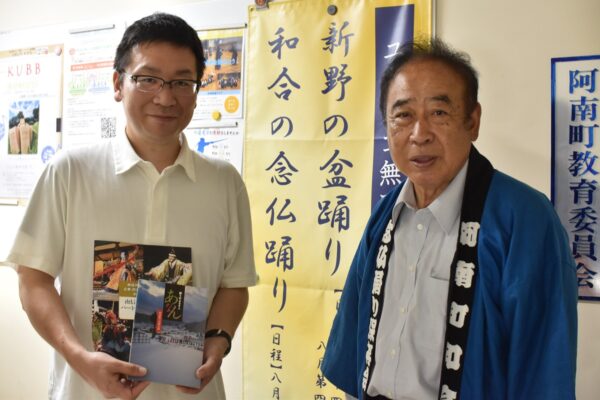
▲Chairman Hiramatsu (right) and Miyashita Zenta (left) of the Anan Town Board of Education, who is the next head of the Miyashita family (29th generation)
On the 14th and 15th of Chunichi, this is an event for the memorial service of the new Buddha, and new Buddha memorial tablets were collected and offered at Hayashi Shoji Temple alone. "Wasan" is performed according to the age of the New Buddha.
In addition, on Chunichi, a Bon dance is held before the Nembutsu dance, while on the last day, the Bon dance continues after the Nembutsu dance until the night begins to rise.
By the way, these days, the aging of the people who carry intangible folk cultural assets has become a challenge in various places, but the situation with the "Wagaku Nembutsu Dance" is a little different. In fact, elementary schools in the Wago area are popular for parents and children studying abroad in mountain villages, and young immigrant families are powerful successors. Some immigrants studying abroad in the mountain village are said to have families who aim to participate in the Nembutsu dance. Their vibrancy has been increasing in recent years, and "Wakai Nembutsu Dance Preservation Society" and "South"ShinshuHiramatsu Santake, chairman of the Council for the Promotion of the Inheritance of Folklore Entertainment, speaks.
"We need 30 dancers dancing in short happi coats and pants. About 15 years ago, when I became chairman, the number was close to the limit, and it was a problem if we would continue like this, we would have to ask women to do so, but now there are 60 dancers, even among the residents of the district alone. With the registration of the UNESCO Intangible Cultural Heritage, young people are becoming more motivated, and I feel that the interest from outside is also increasing."
But SouthShinshuLooking at the whole story, the lack of successors to the festival has become even more serious due to the COVID-19 pandemic. There, "South"ShinshuThe Council for Promoting the Inheritance of Folklore Entertainment has launched a rare project nationwide, seeking support from companies to train successors and pass on to the future, and asking employees to encourage participation in folk entertainment. The efforts to support valuable assets that must be left in the future across the region will liven up traditional culture as a new life.

Wagai Nembutsu Dance Preservation Society (Wagai, Anancho, Shimoina District)
phone:0260-22-2270(Anan Town Board of Education)
https://mg.minami.nagano.jp/(SouthShinshuEntertainment Navi)
*This article is information as of July 2023.















